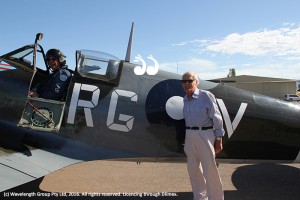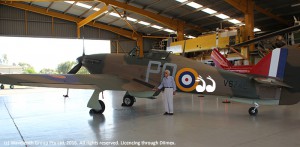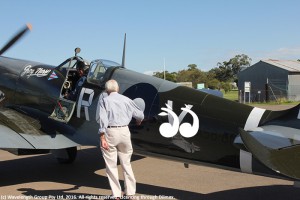WWII Spitfire Pilot Visits Old Friend
EVEN at the age of 92 Lysle Roberts, a World War II spitfire pilot, still had a tear in his eye when he heard the familiar sound of a Rolls Royce Merlin engine in Scone on Saturday.
He said it is nostalgia which wells to the surface and for the rest of us it serves as a reminder that the real marvel of a war bird is not about a plane which pilots were thrilled to be able to manoeuvre with a finger, it was about the machines men relied on to take them into battle for our freedom.
In a town such as Scone there has long been reverence for the role of the horse in battle, but at the air show on the weekend there was also reverence for the role the machine and the men at the controls.
The life of a pilot in WWI and WWII was notoriously short, but people like Lysle flew those missions.
Necessity is the mother of invention, so it is not surprising that during war innovations in all areas are made and hence the spitfire was born, it helped the allies climb higher and faster than the enemy and worked in perfect tandem with the Hurricane, which was also flown at the weekend.
It is then that you can begin to appreciate the significance of a Spitfire and a Hurricane flying in formation for the first time since WWII and why so many people flocked to Scone to witness the event.
Lysle Roberts was among the crowd in Scone and one of only ten remaining spitfire pilots who flew in WWII.
At the age of 12 he had been inspired to fly a spitfire.
“I had read Biggles,” he laughed.
“And when I started to read about the spitfire I said to myself, I didn’t tell anybody else, I said ‘I’m going to fly one of those one day’ and that’s what I set my heart on doing,” he said.
“I joined on New Year’s Day 1943, I was 18 and I joined as soon as I could,
“I trained at Bradfield Park and then Narrandera on the Tiger Moth, Uranquinty on Wirraways and two of us were lucky to be chosen to go to Mildura where we were allotted to Spitfires,” he said.
“I fought in spitfires fending off the Japanese in Australia,” he said.
“The Japanese were starting to ease off when I got up there, but we did have some scares.
“There was little airstrip called Drysdale Mission which was the closest airstrip to Timor and we wanted a new bomber strip which was built and was called Truscott, but while Truscott was being surveyed and built the Japanese were very interested and used to come in very frequently to see what we were up to and we were at the little airstrip Drysdale not far away chasing them off the whole time.
“When we were relieved and another squadron went in to do the same job we were then told that a Japanese taskforce was going to attack the marine base in Fremantle so two squadrons, 452 and 457 flew down in a cyclone to Perth to protect it, but whether the Japanese heard we were down there or not we don’t know but they didn’t make the attack.
“While I was at Drysdale which was February 1944 one of the workman over at Truscott reported that he had heard a diesel engine running at about 1 or 2 in the morning.
“He told the CO in the morning and the CO didn’t believe him and it wasn’t until after the war that the Japanese admitted that a Japanese submarine had come in underneath the Peninsula and they landed Japanese on West Australian soil, but they found the country so devastating that they couldn’t get out quick enough, so they got back in the submarine and this fella heard them going out,” he laughed.
Lysle’s face still lights up when he recalls the first time he took off in a Spitfire.
“I don’t really know how to explain it, it is just so mind blowing,” he said.
“The first time I got into a spit fire I’d been told what to do and hopefully you’ll do it as it should be done, so I got to the end of the strip and I opened the throttle and the pressure back against the back seat was quite incredible and suddenly I realised I was in the air, just like that!
“I’ve never flown a plane like it, I’ve flown Mustangs, Kitty Hawks, Mosquitoes and Avro Ansons, but never…
“And the beauty of it was you could fly it with the tip of your index finger and it responded immediately.
“That was a Marc 5 C, when we bought the Marc 8 out it was a little more severe on the controls, it wasn’t as light and as delicate as the Marc 5 had been; it was still a beautiful aeroplane to fly.
“To see it on the ground beside other aircraft it looks so innocent and so pretty and yet you put it into the air and suddenly it become a lethal machine.
“It was so versatile, it was a defence fighter, a photo reconnaissance aircraft and we were using it for dive bombing and they even had them for seaplanes, but that was rather disastrous because the balance was always incorrect.
“I’ve spoken to Alex Henshaw who was one of their number one test pilots and he’d flown many other aircraft and he said just the sheer delight and the handling of the Spitfire with very few vices if any I never, found any vices whereas in other aircraft you had to be careful of this that or the other because it didn’t always perform well.
“But let’s not underrate the Hurricane, the Hurricane did a fantastic job, but as the war progressed the Hurricane didn’t have the ability to climb a: as fast or b: as high and the Messerschmitt and the Fockes were coming in higher and higher and higher.
“So it was decided the Hurricane couldn’t cope with that so it should attack the bombers on a lower level and the Spitfire which the Marc 5 I had, had no trouble getting to 35,000 feet and I’ve had the Marc 8 at 42 and a half, but never underestimate the Hurricane it did a fantastic job.
“The beauty of it was in its manufacture it used cloth instead of metal in certain areas so that it if was shot up in the morning and came back torn, they’d patch it up and it was ready in the afternoon, which you couldn’t do that in a Spitfire,” said Lysle Roberts.
Lysle still loves to see a spitfire in action and remember what it was like to be at the controls, but he did have one niggling annoyance when he watched the Spitfire fly in Scone on the weekend.
“I don’t like the way the Spitfire was painted and I’ll tell you the story why; 457 was formed in England and came out to Australia, I joined it and half way through my tour in about May or June ’44 we were changed from number one fighter wing to number 80 fighter wing and when we changed over we moved from the Marc 5C to the Marc 8 and we flew the Marc 8 as a perfectly plain, beautifully streamlined aircraft like the Hurricane, until I left in November,” he said.
“In those days we were allowed to put our own insignia, there was Jiminy Cricket or Pinocchio and I had a beautiful blonde called Rhapsody in Red,” he laughed.
“They were just plain, just like the Hurricane and the fellows who had been fortunate enough to shoot down Japanese or Germans used to put Swatch stickers or Rising Sons underneath.
“But when we had a change in CO and they got new flight commanders the new CO and one of the flight commanders said ‘we are going to wipe off all of the insignias and we are going to put the shark’s mouth on it and call ourselves the grey nurse’.
“I don’t disagree with that but in a wing you have a squadron leader leading each squadron then a wing commander flying and he should be impartial, then you have a wing commander or a wing captain who is chief of overall and this aircraft out here has the markings of Bobby Gibbs who was the wing commander, he had nothing to do with 452 squadron, people might say ‘you’re petty’, but the teeth destroy the line and the beautiful symmetry of it,” he said.
“I knew Bobby and had a lot of time for Bobby and it was interesting that Bruce Watson who became the Co of 452 and put the grey nurse onto the aircraft eventually agreed, because when David Lowey got the Marc 16 which he has down there (at Temora), Bruce went down for the inaugural flight and he was overheard to say when it flew by ‘it’s certainly got a nicer line without the grey nurse hasn’t it’,” he laughed.
Yesterday, before the Spitfire flew back to Temora where it now hangs, Lysle took the opportunity to say goodbye to an old friend and paused for a moment to touch the insignia.
Related Story: Flight of a Lifetime.
 scone.com.au
scone.com.au

